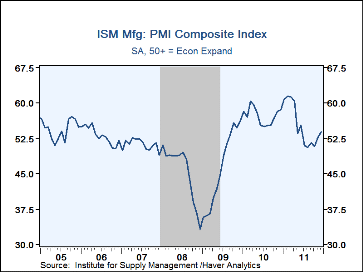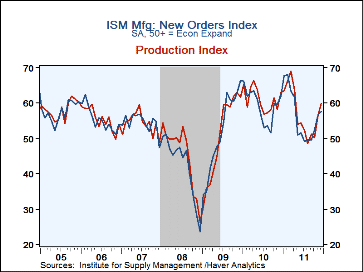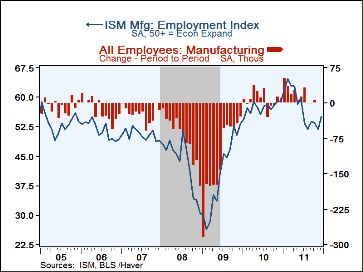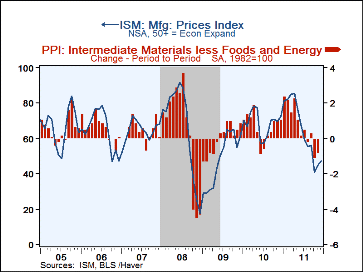 Global| Jan 03 2012
Global| Jan 03 2012U.S. ISM Factory Index Reaches A Six-Month High
by:Tom Moeller
|in:Economy in Brief
Summary
Further improvement in the factory sector is in evidence. The Composite Index of factory sector activity from the Institute For Supply Management rose to a six-month high of 53.9, from an unrevised 52.7 in November. The latest reading [...]
Further improvement in the factory sector is in evidence. The Composite Index of factory sector activity from the Institute For Supply Management rose to a six-month high of 53.9, from an unrevised 52.7 in November. The latest reading beat Consensus expectations for improvement to 53.1. The reading was the highest since June and was the twenty-ninth consecutive monthly figure above the break-even level of 50.
All but one of the index's five components rose m/m, with the strongest gain in production and employment. The production figure was its highest since April and the employment number was its best since June. During the last ten years there has been an 89% correlation between the employment series level and the m/m change in factory sector payrolls. The new orders figure also was its highest since April while the supplier deliveries component showed no change in the speed of filling orders. The inventory index reversed its November gain.
The price index rose to 47.5 but remained below the break-even level of 50 for the third consecutive month. Twenty-one percent of firms raised prices, the least since the recession's end, while twenty-six percent lowered them. During the last ten years there has been an 83% correlation between the index and the m/m change in the core intermediate producer price index.
The separate index of new export orders fell to 53.0, its best since September. Reflecting a better U.S. economy, the imports series rose above break-even for the first time since September.
The ISM figures are diffusion indexes and can be found in Haver's USECON database. The expectations data are in the AS1REPNA database.
The minutes to the latest FOMC meeting can be found here.
| ISM Mfg | Dec | Nov | Oct | Dec'10 | 2011 | 2010 | 2009 |
|---|---|---|---|---|---|---|---|
| Composite Index | 53.9 | 52.7 | 50.8 | 58.5 | 55.3 | 57.3 | 46.3 |
| New Orders | 57.6 | 56.7 | 52.4 | 62.0 | 56.5 | 59.3 | 51.7 |
| Production | 59.9 | 56.6 | 50.1 | 63.0 | 57.5 | 61.1 | 50.5 |
| Employment | 55.1 | 51.8 | 53.5 | 58.9 | 57.5 | 57.3 | 40.6 |
| Supplier Deliveries | 49.9 | 49.9 | 51.3 | 56.7 | 54.7 | 58.1 | 51.5 |
| Inventories | 47.1 | 48.3 | 46.7 | 51.8 | 50.1 | 50.8 | 37.1 |
| Prices Paid Index (NSA) | 47.5 | 45.0 | 41.0 | 72.5 | 65.2 | 68.9 | 48.3 |
Tom Moeller
AuthorMore in Author Profile »Prior to joining Haver Analytics in 2000, Mr. Moeller worked as the Economist at Chancellor Capital Management from 1985 to 1999. There, he developed comprehensive economic forecasts and interpreted economic data for equity and fixed income portfolio managers. Also at Chancellor, Mr. Moeller worked as an equity analyst and was responsible for researching and rating companies in the economically sensitive automobile and housing industries for investment in Chancellor’s equity portfolio. Prior to joining Chancellor, Mr. Moeller was an Economist at Citibank from 1979 to 1984. He also analyzed pricing behavior in the metals industry for the Council on Wage and Price Stability in Washington, D.C. In 1999, Mr. Moeller received the award for most accurate forecast from the Forecasters' Club of New York. From 1990 to 1992 he was President of the New York Association for Business Economists. Mr. Moeller earned an M.B.A. in Finance from Fordham University, where he graduated in 1987. He holds a Bachelor of Arts in Economics from George Washington University.










